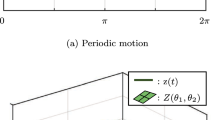Abstract
The complex mechanisms by which nonlinear classical conservative systems undergo a transition from quasiperiodic to chaotic behavior are now fairly well understood. This transition is associated with a breakdown of quasi-constants of motion (KAM surfaces). There is growing evidence that similar mechanisms may govern the behavior of quantum systems. While K-type mixing behavior has not yet been found, there does appear to be a transition associated with the destruction of a quantum quasi-constant of motion (quantum KAM states) which changes qualitatively the spectrum of quantum systems.
Similar content being viewed by others
References
I. Prigogine, A. Grecos, and Cl. George,Celest. Mech. 16, 489 (1977).
T. Y. Petrosky,Phys. Rev. A 32, 3716 (1985).
A. N. Kolmogorov, inFoundations of Mechanics, R. Abraham, ed. (W. A. Benjamin, New York, 1967), Appendix D.
V. I. Arnold,Russ. Math. Surv. 18, 9 (1963);18, 85 (1963).
J. Moser,Nachr. Akad. Wiss. Göttingen II, Math. Phys. Kl. 1, 1 (1962).
E. Fermi:Collected Papers, Vol. II (University of Chicago Press, Chicago, 1965), p. 978.
M. Henon and C. Heiles,Astron. J. 69, 73 (1964).
C. H. Walker and J. Ford,Phys. Rev. 188, 416 (1969).
H. Goldstein,Classical Mechanics, 2nd edn. (Addison-Wesley, Reading, Massachusetts, 1980).
J. Moser,Stable and Random Motions in Dynamical Systems (Princeton University Press, Princeton, 1973).
H.-D. Meyer,J. Chem. Phys. 84, 3147 (1986).
B. Chirikov,Phys. Rep. 52, 263 (1979).
D. F. Escande and F. Doveil,J. Stat. Phys. 26, 257 (1981);Phys. Lett. A 83, 307 (1981);Phys. Scr. T2, 126 (1982).
D. F. Escande,Phys. Rep. 121, 165 (1985).
I. C. Percival, inNonlinear Dynamics and the Beam-Beam Interaction, M. Month and J. C. Herreda, eds. (Am. Inst. of Phys. Conf. Proc. No. 57, 302, 1979).
R. S. MacKay, J. D. Meiss, and I. C. Percival,Physica D 13, 55 (1984).
Y. G. Sinai,Russ. Math. Surv. 25, 137 (1970).
M. V. Berry, inChaotic Behavior in Deterministic Systems, G. Ioosset al., eds. (Les Houches Summer School Proceedings36) (North-Holland, Amsterdam, 1983).
J. Moser, inNeue Züricher Zeitung, May 14, 1975.
R. B. White, inStatistical Physics and Chaos in Fusion Plasma, W. Horton and L. E. Reichl, eds. (Wiley, New York, 1984).
W. A. Lin, “External Field-Induced Chaos in Classical and Quantum Hamiltonian Systems,” Ph.D. Dissertation, University of Texas, December 1986.
W. A. Lin and L. E. Reichl,Physica D 19, 145 (1986).
G. Duffing,Erzwungene Schwingungen bei Verunderlicher Eigenfrequenz (Braunschweig, Vieweg, 1918).
L. E. Reichl and W. M. Zheng,Phys. Rev. A 29, 2186 (1984);30, 1068 (1984).
A. Einstein,Verhandl. Dtsch. Phys. Ges. 19, 82 (1917).
E. Wigner, reproduced in C. E. Porter,Statistical Theories of Spectra: Fluctuations (Academic Press, New York, 1965), p. 200.
M. L. Mehta,Random Matrices (Academic Press, New York, 1967).
T. A. Brodyet al., Rev. Mod. Phys. 53, 385 (1981).
M. Berry,Ann. Phys. (N.Y.) 131, 163 (1981).
O. Bohigas, M. J. Giannoni, and C. Schmit,Phys. Rev. Lett. 52, 1 (1984).
T. Terasaka and T. Matsushita,Phys. Rev. A 32, 538 (1985).
M. V. Berry and M. Tabor,Proc. R. Soc. (London) A 356, 375 (1977).
G. Casati, B. V. Chirikov, and I. Guarneri,Phys. Rev. Lett. 54, 1350 (1985).
T. H. Seligman and J. J. M. Verbaarschot,Phys. Rev. Lett. 56, 2767 (1986).
W. A. Lin and L. E. Reichl, “Transition of Quasienergy Spectral Statistics Due to Nonlinear Quantum Resonance Overlap” (Preprint, University of Texas, December 1986).
L. E. Reichl and W. A. Lin,Phys. Rev. A 33 (Rapid Commun.), 3598 (1986).
G. P. Berman and G. M. Zaslavskii,Phys. Lett. A 61, 295 (1977).
G. P. Berman, G. M. Zaslavskii, and R. Kolovsky,Phys. Lett. A 87, 152 (1982).
G. P. Berman and A. R. Kolovsky,Phys. Lett. A 95, 15 (1983).
G. Hose and H. S. Taylor,Phys. Rev. Lett. 51, 947 (1983).
G. Hose, H. S. Taylor, and A. Tip,J. Phys. A. Math. Gen. 17, 1203 (1984).
R. Ramaswamy,J. Chem. Phys. 80, 6194 (1984).
W. M. Zheng and L. E. Reichl, “Level Mixing in the Stretch Hydrogen Atom,”Phys. Rev. A 35 (Rapid Commun.), January 1987.
Author information
Authors and Affiliations
Rights and permissions
About this article
Cite this article
Reichl, L.E., Lin, W.A. The search for a quantum KAM theorem. Found Phys 17, 689–697 (1987). https://doi.org/10.1007/BF01889542
Received:
Issue Date:
DOI: https://doi.org/10.1007/BF01889542




